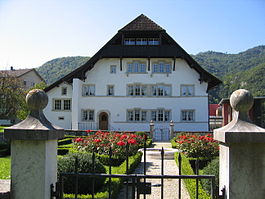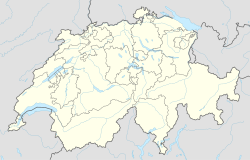Egerkingen
| Egerkingen | ||
|---|---|---|

Old Mill in Egerkingen
|
||
|
||
| Coordinates: 47°19′N 7°48′E / 47.317°N 7.800°ECoordinates: 47°19′N 7°48′E / 47.317°N 7.800°E | ||
| Country | Switzerland | |
| Canton | Solothurn | |
| District | Gäu | |
| Area | ||
| • Total | 6.94 km2 (2.68 sq mi) | |
| Elevation | 440 m (1,440 ft) | |
| Population (Dec 2015) | ||
| • Total | 3,447 | |
| • Density | 500/km2 (1,300/sq mi) | |
| Postal code | 4622 | |
| SFOS number | 2401 | |
| Surrounded by | Gunzgen, Hägendorf, Härkingen, Holderbank, Langenbruck (BL), Neuendorf, Oberbuchsiten | |
| Website |
www SFSO statistics |
|
Egerkingen is a municipality in the district of Gäu in the canton of Solothurn in Switzerland.
Egerkingen is first mentioned in 1201 as in Egrichen. In 1212 it was mentioned as in Egerchingen.
Egerkingen has an area, as of 2009[update], of 6.94 square kilometers (2.68 sq mi). Of this area, 1.72 km2 (0.66 sq mi) or 24.8% is used for agricultural purposes, while 3.44 km2 (1.33 sq mi) or 49.6% is forested. Of the rest of the land, 1.74 km2 (0.67 sq mi) or 25.1% is settled (buildings or roads), 0.02 km2 (4.9 acres) or 0.3% is either rivers or lakes.
Of the built up area, industrial buildings made up 5.5% of the total area while housing and buildings made up 9.2% and transportation infrastructure made up 8.6%. Power and water infrastructure as well as other special developed areas made up 1.2% of the area Out of the forested land, 48.1% of the total land area is heavily forested and 1.4% is covered with orchards or small clusters of trees. Of the agricultural land, 17.6% is used for growing crops and 5.3% is pastures, while 1.2% is used for orchards or vine crops. All the water in the municipality is flowing water.
The municipality is located in the Gäu district, at the southern foot of the Jura Mountains between Olten and Oensingen.
The blazon of the municipal coat of arms is Azure two Fir Trees issuant from as many Mounts all Vert between three Fleurs-de-lis or the middle one inverted.
Egerkingen has a population (as of December 2015[update]) of 3,447. As of 2008[update], 26.5% of the population are resident foreign nationals. Over the last 10 years (1999–2009 ) the population has changed at a rate of 14.1%.
...
Wikipedia




